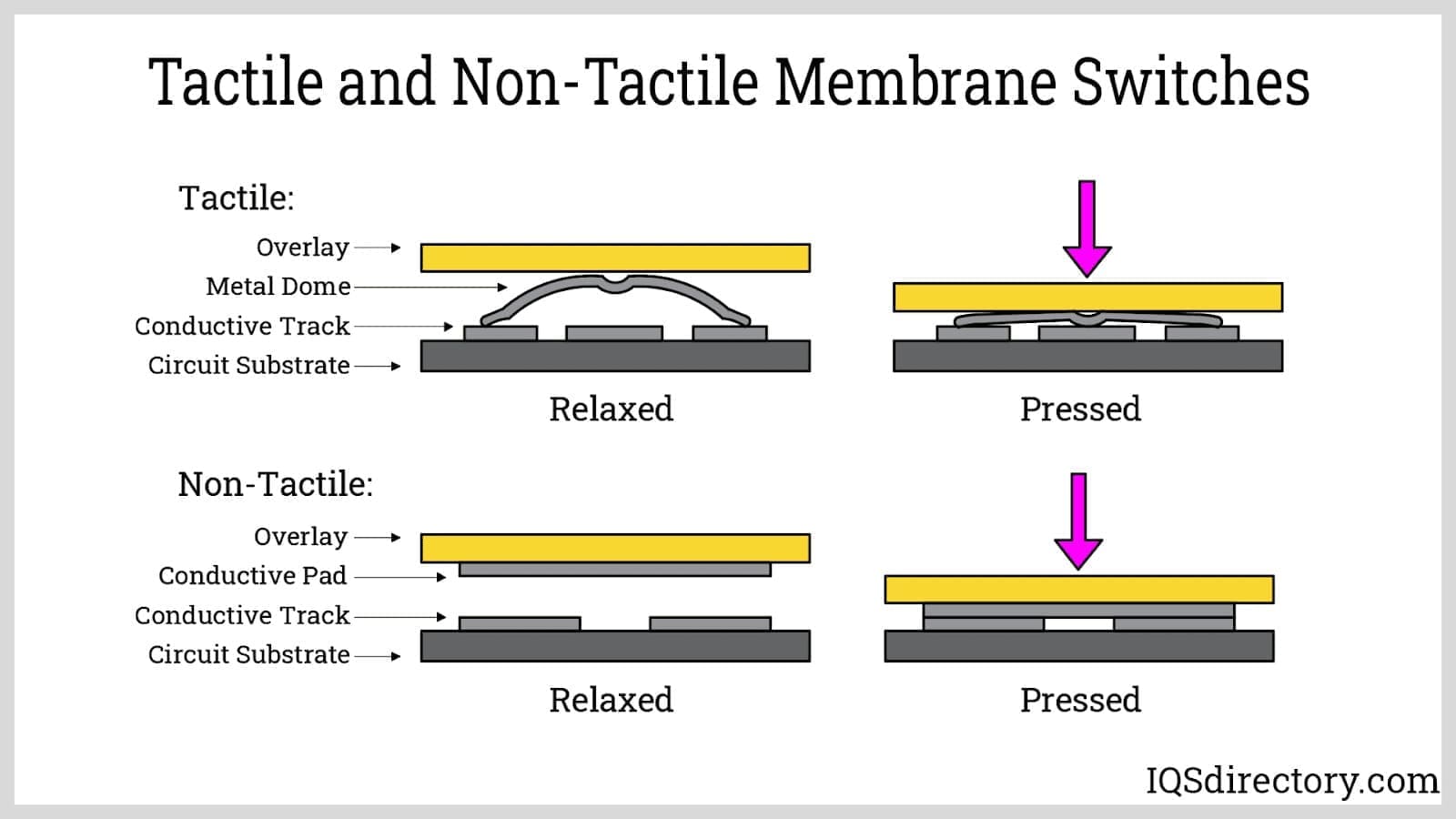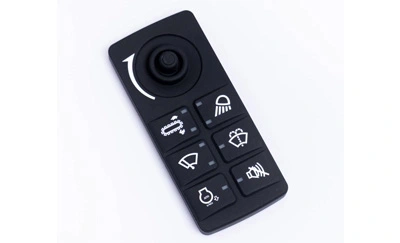Comprehending the Relevance of Membrane Layer Switch Over in Modern Electronic Devices
Membrane switches are essential components in modern digital tools. They use a blend of functionality and layout that improves individual interaction. Their lightweight and long lasting nature makes them suitable for numerous applications. As markets evolve, the need for personalization and advanced features expands. Comprehending how membrane layer switches add to advancement reveals their significance in forming the future of electronics. What exists ahead for this modern technology?
The Fundamentals of Membrane Layer Change Modern Technology
Although usually ignored, membrane switch modern technology plays a crucial function in the modern electronic devices landscape - membrane switch. These gadgets, made up of several layers, function as interface for numerous digital products, varying from house devices to clinical tools. A common membrane button contains a graphic overlay, a spacer layer, and a circuit layer, which are thoroughly set up to create a practical interface.When pressure is related to the overlay, the circuit layer is completed, permitting signals to be transferred to the tool. This technology is understood for its convenience, making it possible for customization in shape, layout, and functionality to meet specific customer requirements. Furthermore, membrane switches are thin and lightweight, making them appropriate for applications where room is a costs. Their sturdiness and resistance to ecological aspects better boost their allure, guaranteeing they can hold up against harsh problems while keeping capability. Generally, membrane layer switch innovation is essential to creating efficient and user-friendly digital gadgets

Trick Advantages of Membrane Changes
Membrane switches over offer several vital advantages that make them a preferred selection in different electronic applications. Their layout permits a compact kind element, making it possible for makers to create lightweight and sleek tools. Furthermore, membrane layer switches are immune to dust, dampness, and chemicals, which improves their resilience and longevity in demanding atmospheres. The tactile responses offered by these buttons can enhance individual experience, making them easy and user-friendly to operate.Furthermore, membrane layer switches can be personalized with diverse graphics and colors, permitting for distinct branding possibilities. The manufacturing procedure is typically cost-effective, particularly for high-volume manufacturing, as it decreases setting up time and streamlines design. Lastly, membrane layer switches require very little upkeep, contributing to lower general functional prices. These benefits emphasize their expanding popularity in modern electronics, where dependability and easy to use user interfaces are important.

Applications Throughout Different Industries
The flexibility of membrane layer changes enables their prevalent adoption throughout various industries. In the clinical field, they are generally utilized in diagnostic devices and patient surveillance systems, providing a durable interface immune to pollutants. The automotive market makes use of membrane buttons for dashboard controls, boosting user experience with smooth designs that stand up to harsh conditions. In customer electronics, they serve as control board for devices such as microwaves and coffee machine, providing an easy to use user interface that is easy to tidy. The aerospace field employs membrane layer buttons in cockpit controls, where dependability and room efficiency are vital. Additionally, the industrial market leverages these buttons in machinery and control systems to guarantee robust procedure sought after environments. This broad variety of applications emphasizes the adaptability of membrane switches, making them important parts in improving capability and customer interaction across diverse technological landscapes.
Personalization and Layout Adaptability

Future Patterns in Membrane Switch Development
Arising fads in membrane layer switch advancement indicate an expanding focus on improved performance and integration with smart technologies. As customer need for a lot more advanced electronic tools rises, makers are focusing on creating membrane layer changes that not only offer standard operational roles yet likewise incorporate attributes like touch sensitivity, backlighting, and haptic feedback.Furthermore, developments in products are expected to boost toughness and ecological resistance, making membrane layer switches ideal for diverse applications in industries such as medical care, vehicle, and consumer electronic devices. The assimilation of capacitive touch innovation is likely to come to be much more widespread, enabling sleeker designs and enhanced user interfaces. membrane switch.Additionally, the increase of the Internet of Things (IoT) is prompting the growth of membrane switches over that can communicate wirelessly with various other devices, boosting interconnectivity. In general, the future of membrane layer switch innovation appears appealing, driven click to investigate by innovation and the quest of straightforward services
Regularly Asked Questions
Exactly How Do Membrane Layer Changes Contrast to Traditional Mechanical Switches?
Membrane layer buttons, being much more space-efficient and supplying a sleek style, comparison with traditional mechanical switches that give tactile comments. The previous often feature personalized graphics, while the last usually assure durability and dependability in numerous applications.
What Products Are Commonly Used in Membrane Change Manufacturing?
Membrane layer buttons are typically created using products such as polyester, polycarbonate, and published conductive inks. These materials offer responsiveness, durability, and flexibility, making them ideal for various applications in electronic devices and user interfaces.
Can Membrane Switches Be Repaired or Recycled?
Membrane layer buttons can typically be repaired, particularly if small problems occur, such as adhesive failing or surface damage. Total reuse is usually limited due to use and potential destruction of materials over time.
How Do Ecological Factors Influence Membrane Switch Over Performance?
Ecological aspects, such as direct exposure, humidity, and temperature level to chemicals, significantly affect membrane layer switch performance. Severe conditions can cause degradation, impacting responsiveness and longevity, eventually compromising the functionality of the device in different applications.
What Is the Normal Lifespan of a Membrane Layer Change?
The regular lifespan of a membrane layer button generally ranges from 1 to 5 million actuations, relying on factors such as usage regularity, ecological conditions, and the materials made use of in production, impacting resilience and click this link efficiency long life. A typical membrane switch is composed of a visuals overlay, a spacer layer, and a circuit layer, which are carefully constructed to produce a useful interface - membrane switch.When pressure is applied to the overlay, the circuit layer is finished, allowing signals to be transferred to the device. The tactile comments provided by these switches can boost customer experience, making them very easy and instinctive to operate.Furthermore, membrane buttons can be personalized with varied graphics and colors, permitting for one-of-a-kind branding chances. As consumer need for extra sophisticated electronic devices increases, producers are focusing on producing membrane switches that not just offer standard functional functions however likewise incorporate features like touch sensitivity, backlighting, and haptic feedback.Furthermore, developments in products are expected to boost durability and ecological resistance, making membrane switches ideal for varied applications in markets such as health care, automobile, and consumer electronic devices. The combination of capacitive touch innovation is likely to come to be a lot more common, allowing for sleeker designs and boosted customer interfaces.Additionally, the increase of the Internet of Things (IoT) is triggering the advancement site link of membrane changes that can interact wirelessly with various other tools, improving interconnectivity. Membrane buttons, being extra space-efficient and using a smooth design, comparison with standard mechanical switches that give tactile feedback